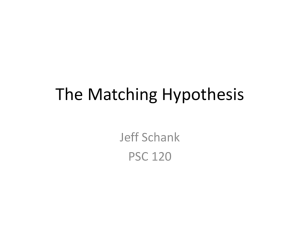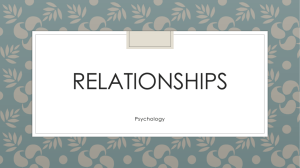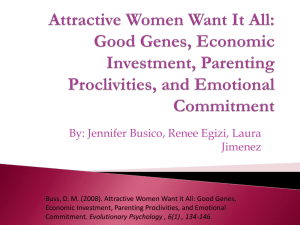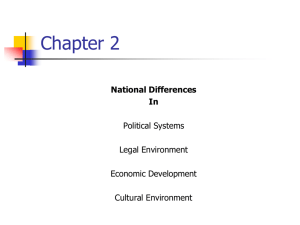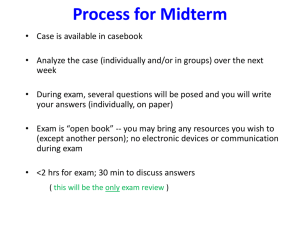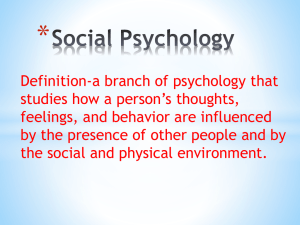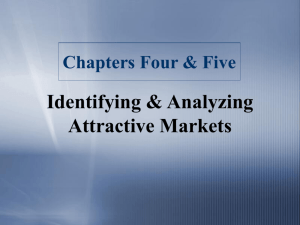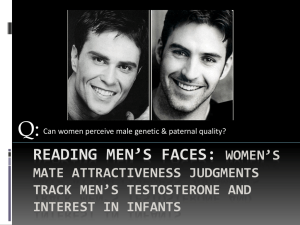Rule 1 - SmartSite
advertisement
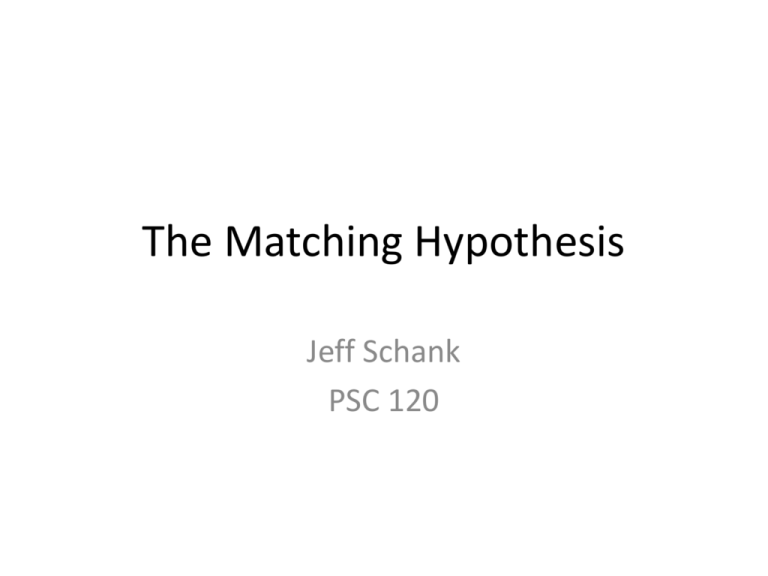
The Matching Hypothesis Jeff Schank PSC 120 Mating • Mating is an evolutionary imperative • Much of life is structured around securing and maintaining long-term partnerships Physical Attractiveness • Focus on physical attractiveness may have basis in “good genes” hypothesis – Features associated with PA may be implicit signals of genetic fitness • Social Psychology: How does physical attractiveness influence mate choice? The Matching Paradox • Assumption: Everybody wants the most attractive mate • BUT, couples tend to be similar in attractiveness • r = .4 to .6 (Feingold, 1988; Little et al., 2006) Matching Paradox • How does this similarity between partners come about? • How is the observed population-level regularity generated by the decentralized, localized interactions of heterogeneous autonomous individuals? (That’s a mouthful!) Kalick and Hamilton (1986) • Previously, many researchers assumed people actively sought partners of equal attractiveness (the “matching hypothesis”) • Repeated studies showed no indication of this, but rather a strong preference for the most attractive potential partners • ABM showed that matching could occur with a preference for the most attractive potential partners The Model • Male and female agents – Only distinguishing feature is attractiveness • • • • Randomly paired on “dates” Choose whether to accept date as mate Mutual acceptance coupling “Attractiveness” can represent any onedimensional measure of mate quality The Model: Decision Rules • Rule 1: Prefer the most attractive partner • Rule 2: Prefer the most similar partner • CT Rule: Agents become less “choosy” as they have more unsuccessful dates – Acceptance was certain after 50 dates. The Model: Decision Rules more Formally ( ) 3 • Rule 1: Prefer the most attractive Ap partner P1 = 1,000 • Rule 2: Prefer the most similar partner 3 10 - Ao - Ap • CT Rule: Agents become P2 = less “choosy” as they have 1,000 more unsuccessful dates (51-d )/ 50 c ( – Acceptance was certain after 50 dates. Pi = ( Pi ) ) Model Details • Male and Female agents (1,000 of each) • Each agent randomly assigned an “attractiveness” score, which is an integer between 1-10 • Each time step, each unmated male was paired with a random unmated female for a “date” • Each date accepted/rejected partner using probabilistic decision rule • If mutual acceptance, the pair was mated and left the dating pool Problem: Model not Parameterized • • • A ) ( P= 3 p 1 1,000 o p Pi = ( Pi ) (51-d )/ 50 kn k- A -A ) ( P = Pi = ( Pi ) 3 1,000 c p 1 10 - A - A ) ( P = 2 A ) ( P= n o 2 c k p n (D -d )/(D -1) n Model Parameterized • Male and Female agent (1,000 of each) Nm (males) and Nf (females) • Each agent randomly assigned an “attractiveness” score, which is an integer between 1 – 10 A random number between 1 – Max(A) What Can We Do? • Replicate the model and check the original results – Are there any other interesting things to check out? • Modify the model – Check robustness of findings – Increase realism and see what happens Replication Rule 1 Rule 2 Kalick and Hamilton r .55 .83 Mean r .61 .83 95% Confidence Interval (.57-.65) (.78-.87) 95% confidence interval means 95% of simulations had results in this range. Choice of Exponent n • K & H used a 3rd-order power function with no explanation • What happens when we change the power? Choice of Exponent n 1 Population Correlation 0.8 0.6 0.4 P1 = Rule 1 0.2 Rule 2 P2 = 0 0 1 2 3 n 4 ( ) Ap 10 n ( 10 - Ao - Ap 5 P3 = n 10 n P1 + P2 2 Pic = ( Pi ) (51-d )/ 50 ) n Space and Movement • Usually, agents are paired completely randomly each turn – Spatial structure can facilitate the evolution of cooperation (Nowak & May, 1992; Aktipis, 2004) – Foraging: Different movement strategies vary in search efficiency and behave differently in various environmental conditions (Bartumeus et al., 2005; Hills, 2006) • Agents were placed on 200x200 grid (bounded) allowing them to move probabilistically • Could interact with neighbors only within a radius of 5 spaces Space and Movement Zigzag Brownian Space and Movement 0.9 0.8 Population Correlation 0.7 0.6 0.5 Original ZigZag 0.4 Brownian 0.3 0.2 0.1 0 Rule 1 Rule 2 Space and Movement • Movement strategies and spatial structure influence mate choice dynamics • Population density should influence speed of finding mates, as well as likelihood of finding an optimal mate • Suggests the evolution of strategies to increase dating options (e.g., rise in Internet dating) • Provides new opportunities for asking questions about individual behavior and population dynamics Conclusions • The Matching Paradox still remains • There are parameter values for which either rule can match the data • Perhaps both rules are two simple Mathematical Structure of Decision Rules • Qualitative difference easy to explain: – Accept a mate with a probability that increases an agent’s objective maximizing: attractiveness (Rule 1) or similarity (Rule 2) • There are many functions that could fit this description – Why a power function? – What is the probability of finding a mate? – Is this the same for each rule? 3rd-order P1 = P2 = ( ) Ap 3 10 3 (10 - A - A ) o 10 p 3 3 Mathematical Structure of Decision Rules A B 0.35 0.3 Average Probability Probability of Matching 0.3 0.25 0.2 0.15 0.1 0.2 0.1 Rule 1 0.05 Rule 2 0 1 2 3 4 5 6 7 8 9 0 10 Rule 1 Attractiveness P1 = (A ) p 10 3 3 P2 = ( 10 - Ao - Ap 10 3 ) 3 Rule 2
